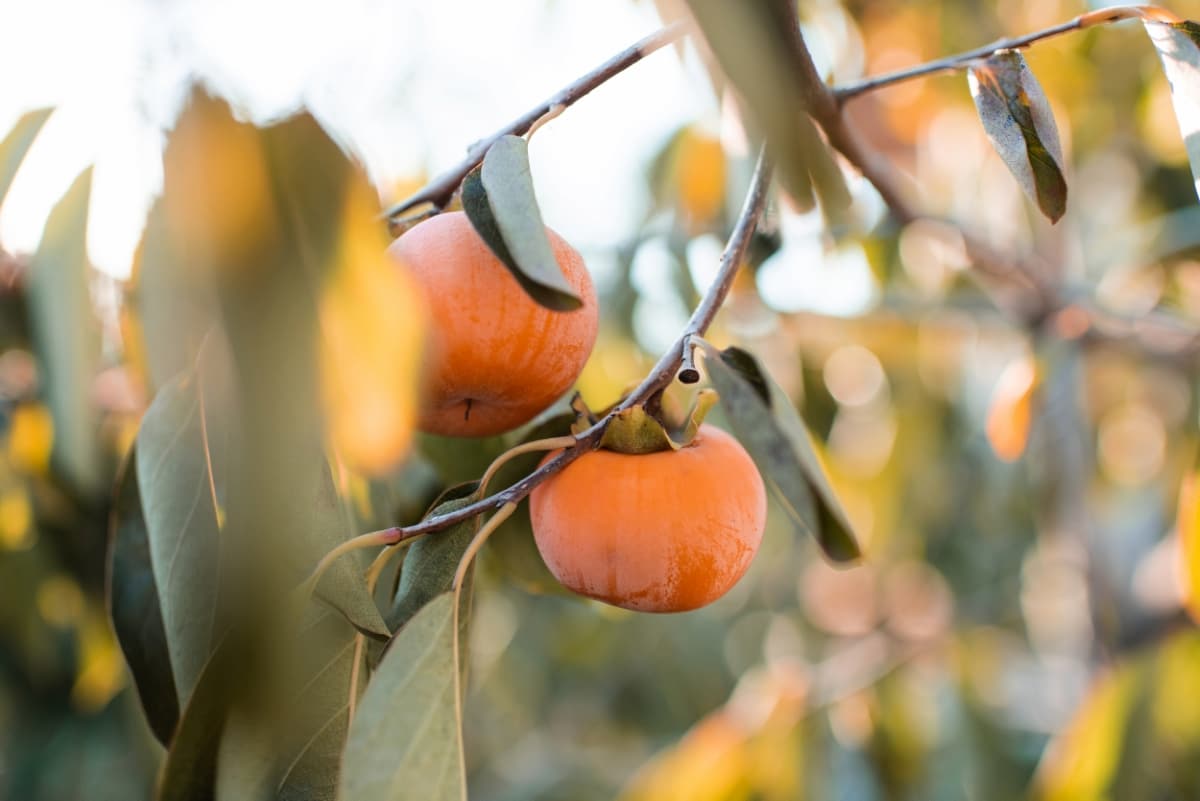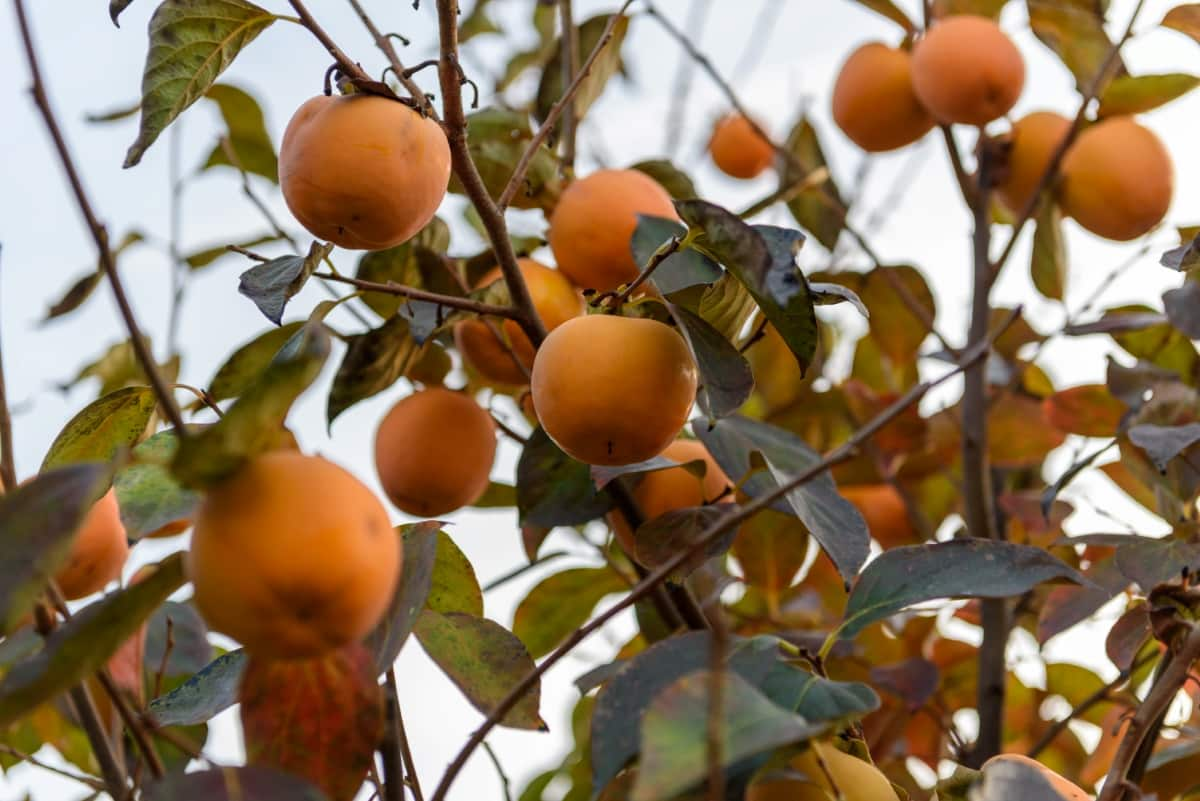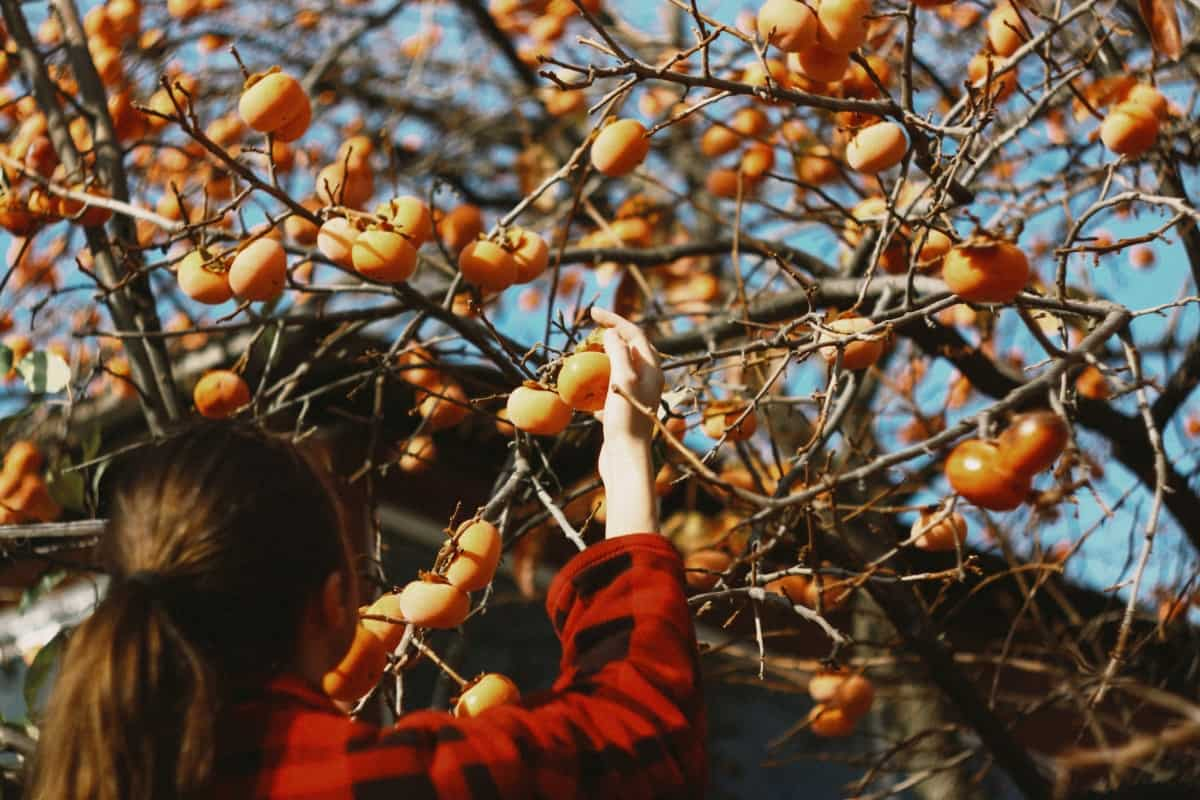A persimmon tree is a beautiful addition to any garden or landscape. However, sometimes these trees can experience problems that lead to their death. There are several reasons why a persimmon tree may die, and fortunately, there are steps you can take to fix the issue.

9 Causes of Dying Persimmon Tree
Why is My Persimmon Tree Dying in Summer Heat, and How Can I Save It?
Excessive heat can cause stress to the tree. The persimmon tree may struggle to survive if the temperature is consistently above 33°C. The leaves may sometimes turn yellow or brown and fall off.
- It is important to protect the tree from the sun’s direct heat. This can be done by providing some shade, either by planting the tree in a location that receives partial shade or by placing a shade cloth over the tree.
- Persimmon trees require well-draining soil that is rich in organic matter. If the soil is too heavy or clay-like, it can prevent water from reaching the roots, causing the Persimmon tree to wilt and eventually die. Add vermicompost or other organic matter to improve soil quality, and plant the tree in a well-draining location.
Preventing Persimmon Tree Death from Fungal Infections: Effective Remedies and Prevention Tips
Anthracnose
- This disease can cause leaf spots, stem cankers, and fruit rot, ultimately leading to defoliation and dieback. Anthracnose can be prevented by maintaining good sanitation practices and removing infected plant material.
- Copper-based fungicides are often used to control anthracnose disease in persimmon trees.
Root Rot
- This disease can result in stunted growth, yellowing leaves, and death. It is important to ensure proper drainage and avoid overwatering to prevent root rot.
- Some of the most common fungicides used for root rot disease in persimmon trees include azoxystrobin, propiconazole, and thiophanate-methyl.
Powdery Mildew
- Powdery mildew disease causes a white powdery coating on leaves, eventually leading to defoliation. Powdery mildew can be treated with fungicides, but removing infected plant material is important to prevent the disease from spreading.
- Choose products that have active ingredients, such as sulfur, copper, or neem oil. These ingredients are effective in controlling the disease.
Identifying Nutrient Deficiencies in Persimmon Trees and Remedies to Revive Them
Nitrogen Deficiency
- The yellowing of leaves and stunted growth can identify this.
- To solve this issue, fertilizers high in nitrogen, such as ammonium sulfate or urea, can be applied to the soil.
Phosphorus Deficiency
- This can cause slow growth and small fruit production.
- Fertilizers high in phosphorus, such as bone meal or rock phosphate, can be added to the soil.
Potassium Deficiency
- This will cause leaves to wilt and turn yellow.
- Fertilizers high in potassium, such as potassium sulfate or potassium nitrate, can be applied to the soil.
Magnesium Deficiency
- The yellowing of leaves between the veins characterizes magnesium deficiency.
- You can apply magnesium fertilizers such as Epsom salt or dolomite to solve this.
How to Protect Persimmon Trees from Pests and Diseases to Prevent Decline and Death
Spider Mites
- These tiny pests feed on the underside of leaves, causing yellowing and speckling. They can cause the leaves to drop prematurely.
- Neem oil: This natural pesticide can be used to control a variety of pests, including psylla and mites.
Persimmon Psylla
- This insect feeds on the sap of the plant and will cause the leaves to curl and the fruit to become deformed.
- Insecticidal soap: This natural pesticide can be used to control a variety of pests, including psylla and mites.
In case you missed it: 9 Causes of Dying Loquat Trees and How to Fix Them?

Leaf Spot
- Leaf spot is a fungus-caused disease that leads to brown spots on the leaves of the persimmon tree. This disease can weaken the tree over time, making it more susceptible to other diseases.
- Copper fungicides: Copper fungicides are effective at preventing and treating fungal diseases, including leaf spots and anthracnose.
Bacterial Canker
- This bacterial disease affects the bark and wood of persimmon trees. Symptoms include sunken areas on the bark, oozing sap, and wilting branches.
- To protect against bacterial canker, copper-based fungicides can be used.
Overwatering Issues in Persimmon Trees: Signs, Symptoms, and Steps to Rescue a Dying Tree
When persimmon trees receive too much water, their roots become saturated, and they cannot absorb the necessary nutrients from the soil. This results in yellowing leaves that eventually fall off the tree. When the roots of a persimmon tree are continuously exposed to water, they can become waterlogged and begin to rot. This can lead to the death of the tree if left untreated.
- If the tree receives too much water due to environmental factors such as heavy rain, it is best to wait until the soil dries out before watering again.
- If the tree is being overwatered due to poor drainage or improper watering habits, several natural solutions can help.
- Apply organic matter, like compost or mulch, to the soil around the tree. This can help improve soil structure and drainage.
Underwatering Issues in Persimmon Trees: Signs, Symptoms, and Steps to Rescue a Dying Tree
When a persimmon tree is underwatered, its leaves will wilt and turn yellow. As the tree continues to be underwatered, the leaves will eventually dry out and drop, leaving the tree bare. When the tree is not receiving enough water, it will not be able to grow as quickly or as tall as it should. This can lead to a smaller tree size and a less productive harvest. Fruit drop is also a common symptom of underwatering in persimmon trees.
- Stick your finger into the soil around the tree to check the moisture level. If the soil is dry, it is time to water the tree again. Water the tree slowly to allow the water to penetrate deeply into the soil.
- Using a garden hose or a garden watering can water the tree slowly, allowing the water to soak into the soil.
- Apply a layer of mulch with organic materials, such as bark chips or compost, around the tree’s base, being careful not to cover the trunk.
Persimmon Tree Winter Damage/Dying: Protecting Trees from Frost and Cold Temperatures
If temperatures dip below -10°C for an extended period, the tree’s tissues can be damaged, leading to discoloration, dieback, and even death. In addition, the tree may become more susceptible to insect and disease infestations, which can further weaken the tree.
- Wrapping the Persimmon tree trunk with a tree wrap or burlap can prevent sunscald and frost damage. This is especially important for young trees.
- Pruning the tree during late winter or early spring will help promote healthy growth and reduce the risk of winter damage.
- If temperatures are expected to go below freezing, cover the tree with a frost cloth or blanket to help insulate it from the cold.
Improper Pruning May Cause Persimmon Tree Death: Pruning Methods for Healthy Growth
Improper pruning is a common mistake that can cause a persimmon tree’s demise. To ensure healthy growth, it is important to understand the proper pruning techniques for a persimmon tree.
- Persimmon trees are best pruned during their dormant season. During this time, the tree is not actively growing, making it easier to see its structure and make accurate cuts.
- Removing crossing or rubbing branches can prevent tree bark damage and improve airflow throughout the canopy.
- Maintaining a central leader is an important aspect of pruning a persimmon tree. This means allowing one main trunk to grow upwards while removing competing branches. This will help the tree grow tall and strong, allowing for optimal fruit production.
Reviving a Stressed Persimmon Tree Tree: Rehabilitation Methods for Overall Recovery
Stressed Persimmon trees can suffer from various ailments that cause them to wither and die if left untreated. However, reviving a stressed Persimmon tree and restoring it to health is possible with careful attention and rehabilitation.
- Ensuring the soil is well-drained and rich in organic matter is important. Adding vermicompost, animal manure, or other organic fertilizers to the soil can improve its quality and provide essential nutrients to the tree.
- Monitoring the soil moisture regularly is important to ensure that your tree gets the right amount of water.
- Pruning can help improve air circulation and sun exposure, and overall recovery.
- Common pests affecting Persimmon trees include aphids, mites, and scale insects. These pests can be avoided with insecticidal soap or other pest control measures.
- Proper pruning and other management practices can also control diseases like brown rot and bacterial canker.
In case you missed it: 9 Causes of Dying Cherry Trees and How to Fix Them?

Conclusion
In conclusion, a persimmon tree can die for various reasons, including improper watering, poor soil quality, pests, and diseases. To fix a dying persimmon tree, identify the root cause of the problem and take preventive measures to address it. A persimmon tree can thrive and provide delicious fruit for years with proper care.
- Feed Your Flock for Less: Top 10 Tips to Save on Chicken Feed
- Ultimate Guide to Ossabaw Island Hog: Breeding, Raising, Diet, and Care
- Hatching Answers: The Top 10 Reasons Your Chickens Aren’t Laying Eggs
- Eggs and Economics: Breaking Down the Cost of Raising Backyard Chickens
- Defend Your Greens: Proven Methods to Keep Iguanas Out of Your Garden
- Ultimate Guide to Cinnamon Queen Chicken: A Comprehensive Guide for Beginners
- Ultimate Guide to California Tan Chicken: Breeding, Raising, Diet, Egg-Production and Care
- Ultimate Guide to Marsh Daisy Chicken: Breeding, Raising, Diet, and Care
- 10 Types of Chicken Farming Businesses You Can Start for Profits